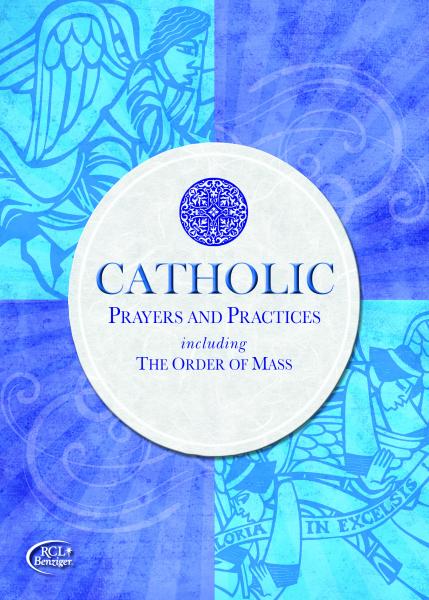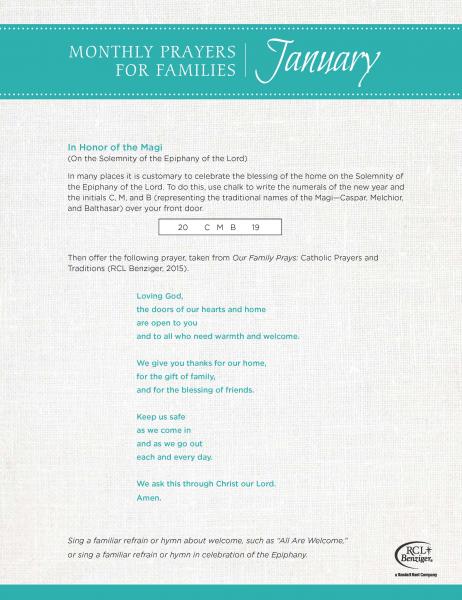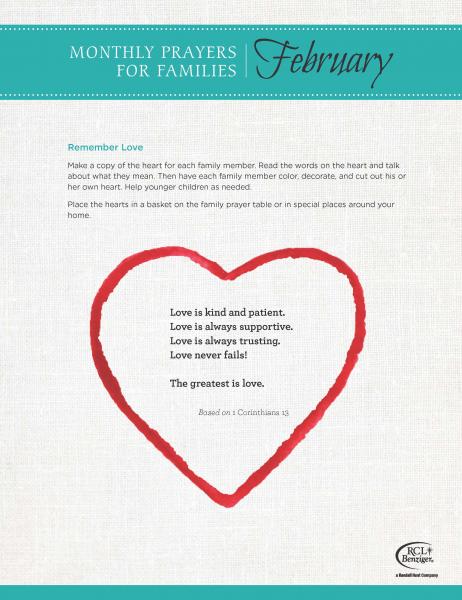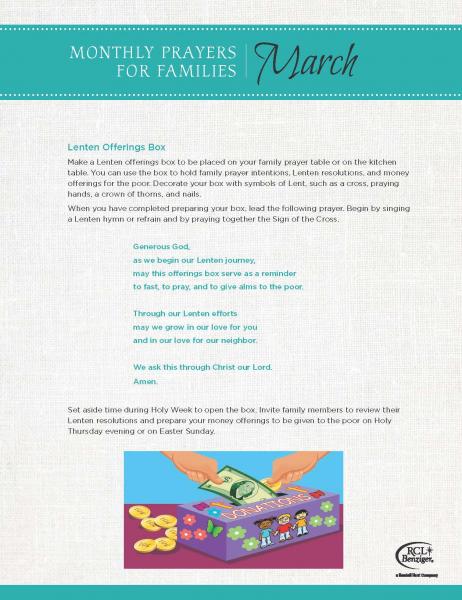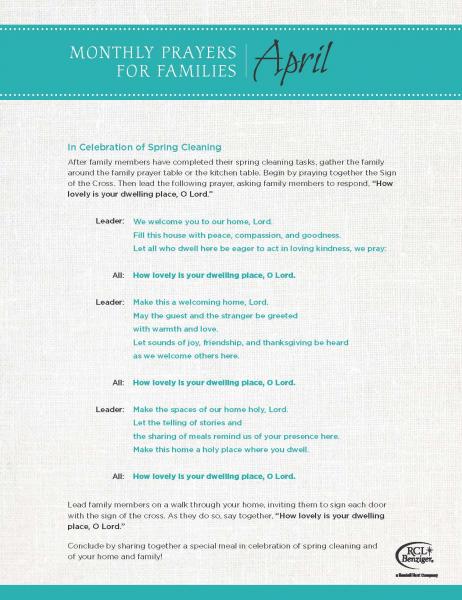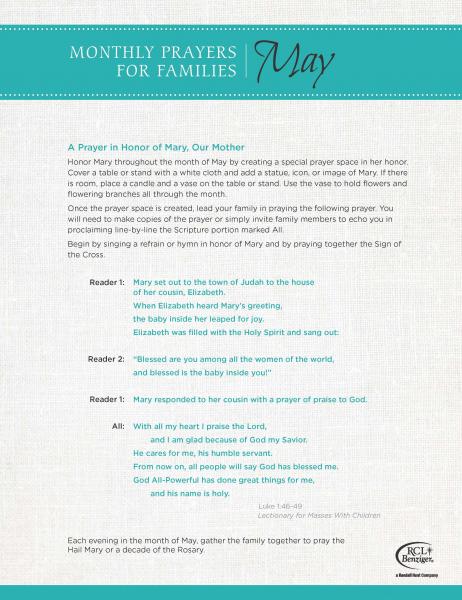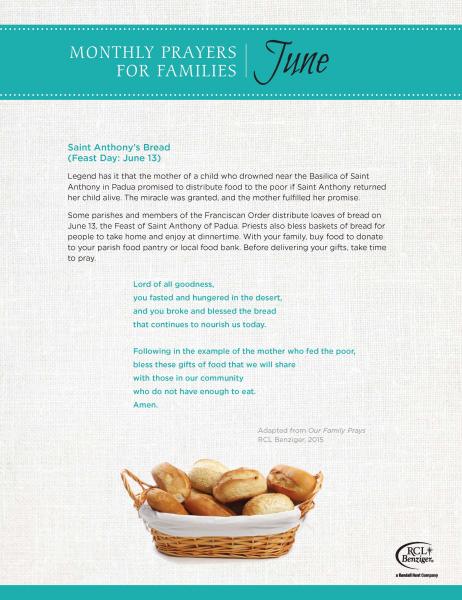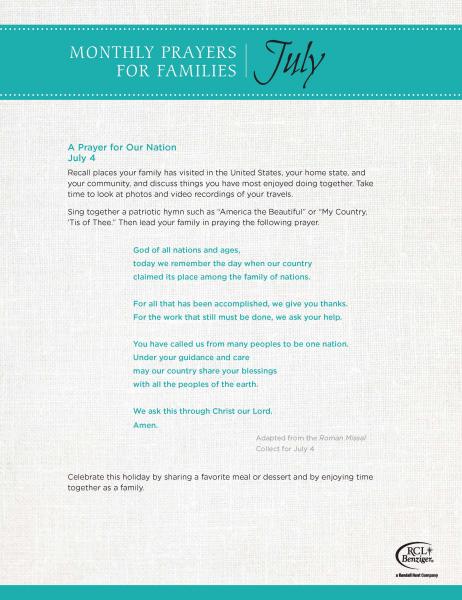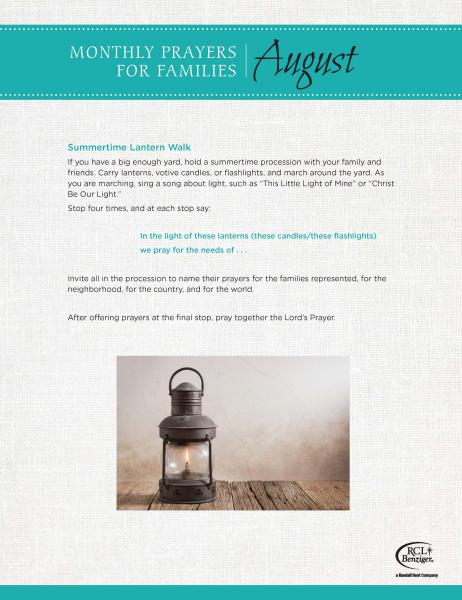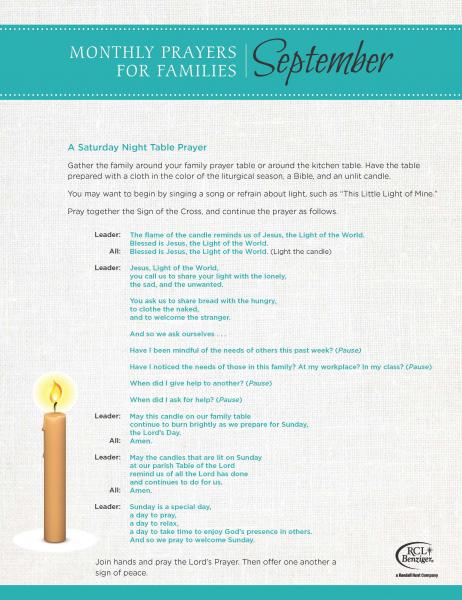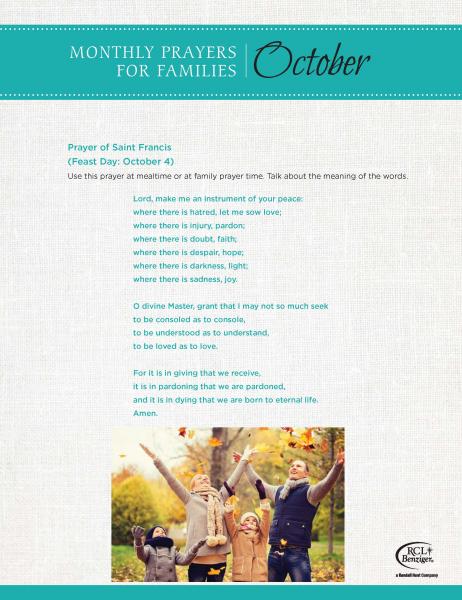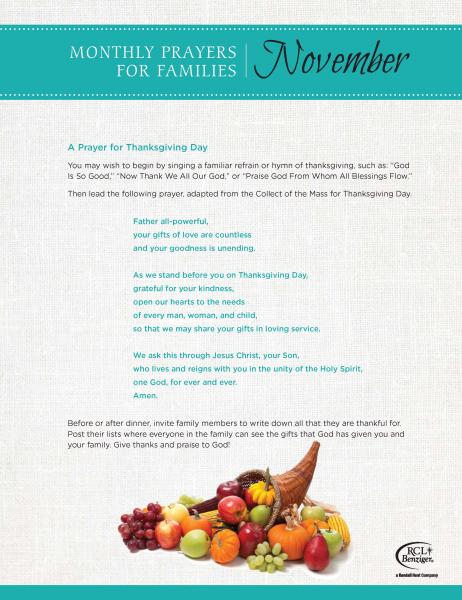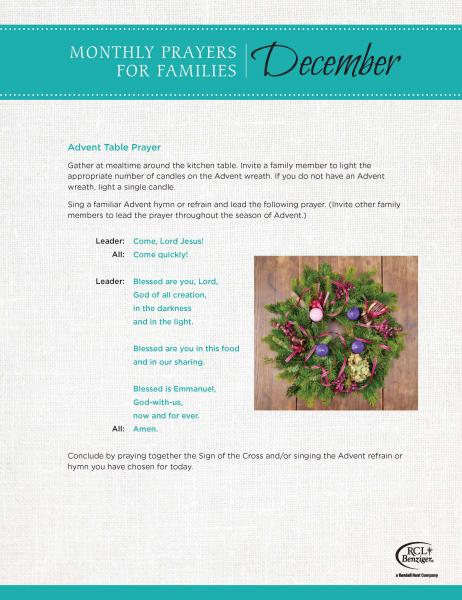Catholic Schools Week 2023

Catholic Schools Week
January 26 - February 1, 2025
Free resources and ideas from RCL Benziger
RCL Benziger is proud to partner with the National Catholic Education Association (NCEA) to celebrate Catholic Schools Week 2025. The theme for this year’s Catholic Schools Week is Catholic Schools: United in Faith and Community.
Catholic Schools Week celebrates the contribution that Catholic education provides to children and youth, to our Church, to our communities, and to our nation. This year we are pleased to again provide you with classroom-friendly resources and suggestions from NCEA to help you celebrate the overall theme and the daily themes of Catholic Schools Week.
RCL Benziger celebrates the gifts and talents of school administrators, principals, teachers, staff members, students, parents, volunteers, and all who share in the ministry of Catholic education. Catholic Schools Week is a time to thank you for all you do and to pray that God will richly bless you as you continue to teach and inspire future leaders and servants of God’s kingdom.
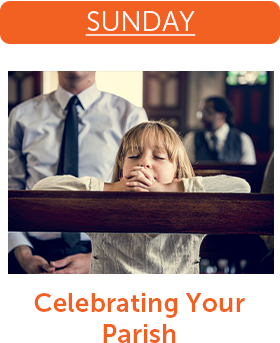 |  |  |  |
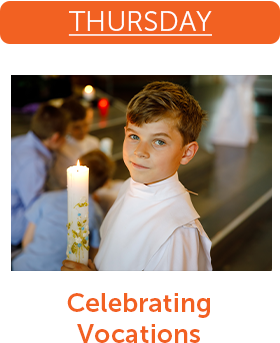 |  |  |  |
Catholic Schools Week - Tuesday

Tuesday, January 31
Celebrating Your Students
Today we celebrate the gifts, talents, and faith of Catholic school students.
Catholic education provides a nurturing environment for children and youth to grow and learn, not only in their academic studies but also in their faith. Through the study of God’s Word, we learn that we are all created in God’s image and that God calls each of us by name. The life and teachings of Jesus Christ serve as the example by which we are to live.
Three Ways to Celebrate the Student-School Connection
- Invite older students to read Bible stories to younger students. Invite younger students to role-play Bible stories for older students.
- Brainstorm with your class or invite small groups of students to name five things they have learned from reading God’s Word. As an alternative, invite younger students to draw pictures of their favorite Bible stories.
- Start a pen-pal program with another Catholic school, perhaps a mission school supported by your parish or diocese.
- Connect classes digitally/virtually and use virtual breakout rooms for older students to read a Bible story to the younger students. Then invite the younger students to draw a picture about the Scripture passage and post it on the school website.
- Send a digital greeting to another school within the diocese or even in another part of the nation or internationally. Discover ways to support each schools’ mission of sharing the Good News of Jesus through prayer, letter writing, and digital communication.
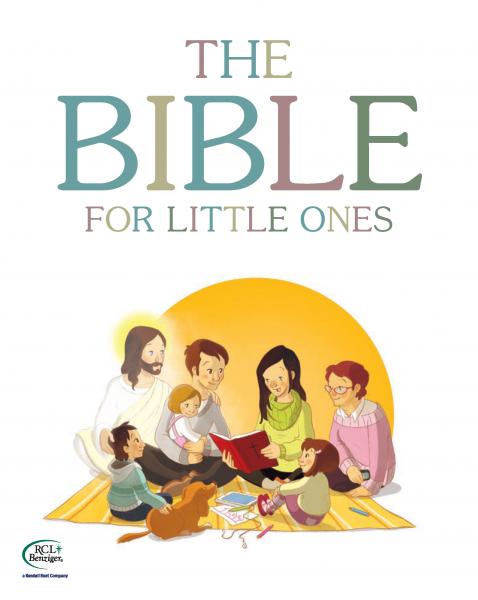
The Bible for Little Ones enriches the lives of children, parents, families, and catechists in their efforts to listen to, understand, and live the Word of God. Children listen to key Bible stories and internalize them through activities and music. This resource is designed for children between the ages of three and seven. Available in Spanish.
Find additional resources for families from RCL Benziger at - OurFamilyFaith.com
Catholic Schools Week - Sunday

Sunday, January 29
Celebrating Your Parish
Today we celebrate the integral connection between parish communities and Catholic schools.
Each Sunday, the parish community comes together to celebrate the Mass. During Catholic Schools Week, many parishes invite adults and students from the school community to take a special role in the liturgy.
Three Ways to Celebrate the Parish-School Connection
- Invite the parish and school choirs to combine talents in leading the music at Sunday Mass.
- Have students make ahead of time thank you cards or special prayer cards to distribute to parishioners at the end of Mass. Messages could be simple, such as “Thank you for supporting our school” or “Please pray for our students and teachers.”
- During the announcements, take time to invite teachers, students, and staff to stand. Also, recognize former students and staff members, and parents of students currently attending your parish’s Catholic school.
- Make digital thank you cards for parishioners that could be distributed via email or social media utilizing the parish distribution list in collaboration with the parish staff. The cards could be designed digitally or made by hand and scanned.
- Consider making a digital presentation (slideshow or video) of students and staff thanking parishioners. Share the presentation before or after live-streamed Mass or share it on social media. Be sure to follow all school and diocesan child-safety guidelines.
- During Mass, include a prayer intention for all students and teachers, especially those in your Catholic school. As an addition or alternative, take time to invite teachers, students, and staff to stand and be recognized during the announcements. Also recognize former students and staff members and parents of students currently attending your parish’s Catholic school.
Catholic Prayers and Practices for Young Disciples and Catholic Prayers and Practices contain the Order of Mass, including the responses and longer prayers of the Mass (Gloria, Creed, and Eucharistic Prayer acclamations). Major signs and symbols of the Church—many a part of the Mass—are also explained.
Catholic Resources

Catholic Resources
Free downloadable resources, prayers, activities, and more.
Learn More
×Request More Information
Try Our Products - 30-Day Digital Trial
SaintsResource.com
OurFamilyFaith.com
RCLBStoriesofGodsLove.com
RCLBSacraments.com
RCLBFamilyLife.com
FlourishRCLB.com
EchoesofFaith.com
ApprenticesInFaith.com
RCLBYoungApprentices.com
RCLBSamples.com
NEW! Easter
NEW! Triduum
Book of Glory for Holy Week Session
NEW! Catholic Schools Week 2021
Week of Prayer for Christian Unity
NEW! Ordinary Time Resources - Winter
A Prayer To Begin a New School Year
Blessing for a New School Year - Resource Packet
Mary, Our Lady - Resource Packet
NEW! Celebrating 50 Years Catholic Campaign For Human Development
Sunday Celebrations - Now part of Praying the Scriptures
NEW! Faith Fuel Blog
The Order of the Mass & The Act of Spiritual Communion
National Marriage Week — (en espanõl)
World Day of the Sick — (en espanõl)
World Day of Prayer for Creation
Dr. Timothy Hogan – Catholic Parenting 101: Tips for Building Strong Catholic Families
Children with Special Needs Teaching Tips
Canonization of Teresa of Calcutta
Parish Products Overview
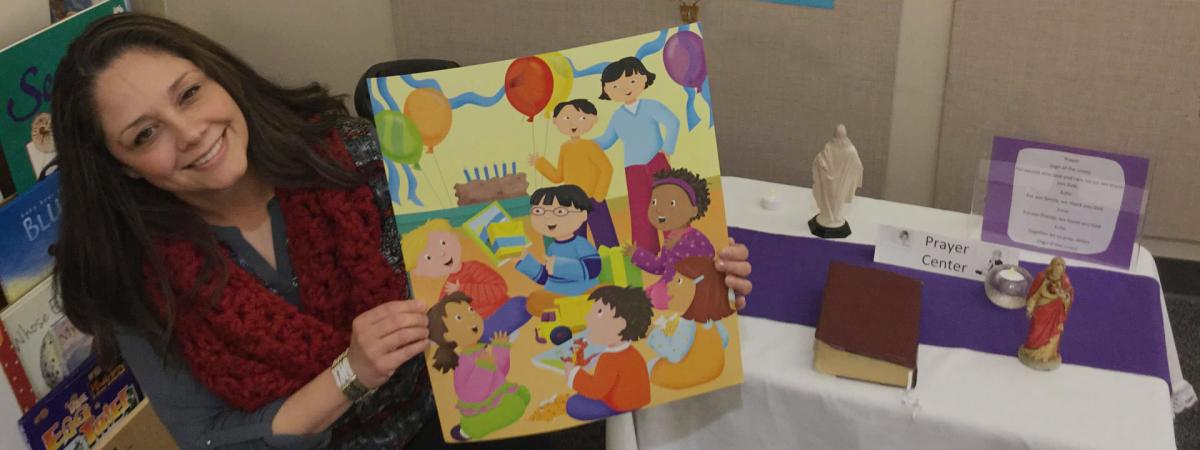
Overview of Parish Products
All of RCL Benziger’s parish resources are rooted in the rich and diverse tradition of the Catholic faith. Our faith formation programs provide an excellent foundation for a lifetime of faith. These parish resources nourish the spiritual wellbeing of each child with the richness of God’s Word, the Church’s teachings, and liturgical expression. Catechists and catechetical leaders are equiped with the tools to foster an environment of Catholic values for learners of all ages and to celebrate these diverse traditions within the Catholic Church. RCL Benziger is committed through our products to support parish life and faith formation by providing families energetic and engaging ways to express and celebrate the Catholic faith.

STORIES OF GOD'S LOVE PRESCHOOL PARISH AGES 3–4 or 4–5 • Kindergarten
RCL Benziger’s complete solution to religion readiness education. Stories of God’s Love is available for both preschool (ages 3-4 or 4-5) and kindergarten. It follows the USCCB’s “Guidelines for Pre-School Materials” and was written by a team of early childhood specialists. This program also meets the early learning standards of the National Association of Education for Young Children (NAEYC). Stories of God’s Love serves as the foundational program for ages 3–4, 4–5, and kindergarten for parishes.
Stories of God’s Love offers:
- A Scripture-based approach, presenting the Bible as the source for learning about God
- Age-appropriate formation with story leaflets and seasonal leaflets
- Lessons of We Celebrate Holy Days and Holidays; includes a Catholic Prayers page
- A family focus that helps children and their families live Christian values
- Available virtues based magazine for families

Give children a sound foundation that leads to faith in action!
Be My Disciples is an innovative and complete religious education program that empowers students and their families to answer the call to discipleship. This new program will lead children and their families to grow in their conversion to Jesus Christ, to develop the habits of discipleship, and to decide each day to choose life in Christ. Using a balanced approach, Be My Disciples is validated by new insights in education today.
Be My Disciples:
- Invites children to discipleship through its catechumenal methodology
- Teaches Scripture, doctrine, and liturgical celebration through its spiral structure
- Challenges children to integrate faith and life through activities and faith choices
Free TrialView Products Program Overview Scope and Sequence Order Review PackProduct Brochure

Blest Are We Faith In Action
New Parish Program for Grades K–8
Key Features:
- Beautifully illustrated covers depicting key Scripture stories
- A new design that is visually appealing to digital natives with an emphasis on digital technology
- Updated Take Homepages for each \chapter that engage families in the faith formation of children in an easy and accessible way
- Increased focus on children with special needs, with teaching tips for catechists in every chapter
- A Faith in Actionfeature that establishes a strong connection to Catholic Social Teaching
INTEGRATED APPROACH
Each unit of Blest Are We Faith in Actionis based on a particular theme or area of Catholic belief and practice. This theme is studied over four individual chapters that correspond to the four pillars of the Catechism:
- What Catholics Believe
- How Catholics Worship
- How Catholics Live
- How Catholics Pray
In this way the essentials of Catholic teaching are presented in an integrated and balanced approach that helps children learn and deepen their faith and Catholic identity.

Select the sacramental catechesis that fits your needs.
The foundations of each of our Sacrament preparation programs are Sacred Scripture, Church teaching, life experience, ritual, and prayer. Our materials focus on engaging children, youth, and their families in developing deeper relationships with Jesus Christ; in preparing children and youth to receive the Sacraments; and in helping families become more active participants in the life of the Church.
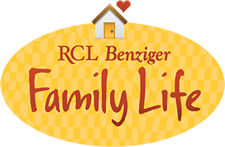
Build strong families, live and share Christian values, and promote child safety!
RCL Benziger’s Family Life (K-8) integrates child safety content within the framework of moral catechesis and Catholic family living. New for the Family Life program is an online eAssessment platform which provides educators with the ability to measure mastery based upon parish, school, or diocesan requirements.

Parish Student Books, Levels 1–6
Features in the Parish student books serve the needs of religion programs with:
- Age-appropriate summary of Church teaching
- Important Scripture knowledge and skills
- 11 lessons for liturgical seasons and feasts
- Take Home family pages
- Faith in Action, which builds a sense of belonging

Separate Guides for Parish or School
Both teacher and catechist guides give you easy-to-follow, flexible plans, along with the background information, teaching tips, and resources you need to bring lessons to life for young people.
Simple, Yet Effective, Three-Step Process
The Engage, Teach and Apply, Connect format keeps young people focused as they discover and learn, then apply and reinforce learning with integration activities. Practical connections to real life help young people see that faith is alive and active.
Activities and Assessment Tools
A variety of activities and assessment instruments are included for every chapter and unit of each student book.
Called to Prayer and Liturgical Lessons
These reproducible resources for all the weeks of Advent, Christmas, Lent, Easter, and Pentecost connect teens with the liturgical life of the parish. Prayer services using a variety of styles of prayer inspire teens to worship.
Helping Kids Live Their Faith
This book explores the seven principles of Catholic Social Teaching and includes age-appropriate service projects.
Sitting on a bookshelf in my home office is a little stuffed animal that holds great memories for me – not from my childhood, or of my children or grandchildren, but from a retreat day I offered for catechists and teachers after school was out for the year.
 It was titled, “Summer Shepherds.”
It was titled, “Summer Shepherds.”
It was my practice to always put something related to the retreat title in the center of each round table where participants sat. I wracked my brains trying to come up with something engaging for this retreat but my usual dollar store visit wasn’t productive.
As I was losing hope and thinking I’d have to resort to simple candles and a basket of chocolates, I visited the local Christian bookstore. There, sitting on top of a large bin as I entered the doors was a little stuffed sheep with long, floppy felt legs, wearing sunglasses and flip flops with a towel flung over its shoulder. I couldn’t believe my eyes! Better still, the bin was full of them.
Of course, they cost much more than a dollar, but how could I not buy them?? They were custom made for this retreat. Summer sheep for summer shepherds!
During these few hours together, we learned more about the relationship between the shepherd and his or her sheep. It enabled us to get a better understanding of what it means to say, “The Lord is my Shepherd.”
We also discussed the different means of shepherding that happened in the summer, depending on where the shepherding takes place. In cold climates, shepherds lead their flocks to the best pastures during summer, to ensure plenty of grass and cool water. They build shelters and stay put to allow sheep to eat well and grow fat so they can get through the winter months.
For shepherds, summer is a time of building relationships with their sheep, which allows them to keep them safe from wolves. Sheep that are injured by wolves are often too afraid to move from their spot, but they will respond to the voice of the shepherd letting the shepherd know where they are so they can be rescued.
On a more serious note, we discussed how, as shepherds, religious educators walk in the footsteps of Jesus and need to nurture their own faith lives, something Jesus did, as well. A big part of his self-care was taking time away, and during that time entering into prayer and conversation with his Father.
While religious educators, whether teacher or catechist, are not often in contact with their students during the summer, except for a few weeks of summer programs, our retreat encouraged them to use the summer to build their own relationship with God.
We all agreed the summer is the time to be intentional about growing our own faith to ensure we can provide the best for our students once the fall, and the school year, comes around again.
Some of the suggestions which came from religious educators themselves included:
- Keeping a gratitude journal during the summer. This is particularly helpful when life is throwing challenge after challenge at you.
- Use the front porch or backyard as a place for prayer to grow in appreciation for God’s creation. This is wonderful exercise to do on vacation, whether you are near the ocean, a lake, camping or hiking.
- Add a visit to Mass during the week. Spend some time in the Adoration chapel if there is one.
- Visit a church that is not your own. Reflect on how its unique beauty is different from your church, and how it is the same as a place where the People of God worship. How do you find God there?
- Pray more often. As part of your prayer practice, tell God honestly what is keeping you from worship, from prayer, from trusting God, or anything else you feel is an impediment. Ask questions and then ask God to provide answers. They often come in the words and works of others. Stay open.
- Read. Most of the retreatants preferred actual books, rather than virtual or audio versions. For them, there is something about the ritual of choosing the book, holding the book and turning the pages that makes reading in this way impactful. Some chose to read more Scripture at least one day a week, others choose books on saints or other specifically religious pieces. Others decided to be intentional about reading books they’ve been planning to read but never got to, and to be mindful of the faith elements in the stories. How did God work in the lives of the characters?
- Everyone agreed to keep a copy of the Twenty-Third Psalm (The Lord is My Shepherd), provided in their folders, for daily reading and memorization. Many had it memorized already and acknowledged that praying it during difficult times was an assurance and comfort. Some reflected on one verse at a time to gain a better understanding their relationship with God. What does it mean to say, “I shall not want”?
- Everyone agreed that shepherds also needed to don sunglasses and flip-flops and throw a towel over their shoulder and enjoy some down time – another entry in the gratitude journal.
 About the Author
About the AuthorMary Clifford Morrell, mother of six and grandmother to ten, is a Catholic journalist, editor, and author who has served the Dioceses of Metuchen and Trenton, New Jersey; Burlington, Vermont, and RENEW International in the areas of religious education and communication.
Ordinary – it’s a word that implies “nothing special,” “commonplace,” having no distinctive features.
 When we talk about Ordinary Time of the liturgical year in the Church, we may think of it as a time when nothing special is going on in between the beautiful and meaningful seasons of Advent and Christmas, Lent and Easter.
When we talk about Ordinary Time of the liturgical year in the Church, we may think of it as a time when nothing special is going on in between the beautiful and meaningful seasons of Advent and Christmas, Lent and Easter.
Nothing could be further from the truth.
While the special seasons of the Church include such important events as the Incarnation, Jesus’ death on the Cross, Jesus’ Resurrection and Ascension, and the coming of the Holy Spirit at Pentecost, Ordinary Time allows us to journey with Jesus as his life unfolds.
There is nothing ordinary about that.
The United States Conference of Catholic Bishop’s describes Ordinary Time as “a time for growth and maturation, a time in which the mystery of Christ is called to penetrate ever more deeply into history until all things are finally caught up in Christ.”
As adults, we may have an understanding of what that means, but how can we impart such a complex concept to students?
Start with the small things. Children learn quickly that there can be no big things without the small things. Whether working with numbers or Legos or magnetic tiles, it’s visually obvious that the first small piece is needed in order to make something big.
It’s like that in religious education as well. With young children we start with something they understand – love – and repeatedly remind them that God loves them. Of course, love is not really a small thing or an ordinary thing, but it is a first thing if children are to grow into adults who want to know and love God, and to come to understand how each step in Jesus’ daily life, each decision, each person he met, each hour of prayer, led him to those important events that we remember, honor and celebrate during Christmas and Easter.
How can Ordinary Time be included in the classroom?
Begin with the color green – The liturgical color for Ordinary time is green. With younger students who cannot yet grasp the meaning of ordinary, changing colors on the prayer table or classroom displays can help them understand that this time in our faith life (when we try to get to know Jesus better) is a time of growth, like the flowers and plants of spring. Nature is a wonderful teacher for growing faith. Also, keep a liturgical color calendar in your classroom. It serves as a visible reminder to students that there are distinct seasons in the life of the Church.
Rewrite a chapter in Jesus’ life – Choose one of your favorite stories about Jesus from the Gospels, read it with the students, and then ask them how Jesus’ life, and the life of those in the story, might have changed if that event hadn’t happened. Bring the discussion back to the significance of the event, what it has taught millions of people since then, how it has been one of the building blocks of our faith. Following Jesus during Ordinary time helps us to build our faith.
Remind students they are disciples – Ordinary time is an opportunity to become familiar with the life of the Apostles, the first disciples, as they accompanied Jesus for three years on his mission. They were ordinary men, with distinct personalities, strengths and weaknesses. They were chosen by God for a purpose and made an extraordinary difference for the world to come. The calling of the Apostles appears in all four Gospels. Read, with or for students, Matthew 4:18-22, Mark 1:14-20, Luke 5:1-11, and John 1:35-51. Allow students to discuss their own strengths and weaknesses and ways in which they can use them to do great things for God.
For Teachers: For those who wish to gain a better sense of who the Apostles were, I enjoyed “Twelve Ordinary Men” by John MacArthur. MacArthur writes about the Apostles from known facts in the Bible, provides additional information from church tradition, and focuses on their character qualities. Ordinary time is the perfect time to consider the extraordinary possibilities of ordinary people.
To read more about liturgical year and seasons of the Church visit Liturgical Year and Calendar | USCCB.
 About the Author
About the AuthorMary Clifford Morrell, mother of six and grandmother to ten, is a Catholic journalist, editor, and author who has served the Dioceses of Metuchen and Trenton, New Jersey; Burlington, Vermont, and RENEW International in the areas of religious education and communication.
The word vocation has a broad meaning and is often misunderstood, but at its core it is a call. The Second Vatican Council defines vocation as the “universal call to holiness” that is in the heart of every human being. This call is an invitation from God to love others and to love God. The distinct way you live out that love is your vocation. Every vocation is a religious vocation because God does the calling.
 God extends a personal invitation to each of us. “Vocation,” according to Pope Francis in his exhortation Christus Vivit, “has nothing to do with inventing ourselves or creating ourselves out of nothing. It has to do with finding our true selves in the light of God and letting our lives flourish and bear fruit.”
God extends a personal invitation to each of us. “Vocation,” according to Pope Francis in his exhortation Christus Vivit, “has nothing to do with inventing ourselves or creating ourselves out of nothing. It has to do with finding our true selves in the light of God and letting our lives flourish and bear fruit.”
Qualities for Vocations. Explore the “Growing in Virtue” segments found in each chapter in your Family Life program. Also, look up “virtues” in your Blest Are We Faith in Action and Be My Disciples program books. Explain to students that virtues are qualities we can develop to help us live our universal vocation, our call to holiness.
Flowing from Baptism. The ministry of lay Catholics, whether formally instituted by the church or simply inspired by the Holy Spirit to serve the needs of others, flows from baptism and a recognition that every Christian is called to take part in the mission of the church. As Pope Francis said, "All ministries are an expression of the sole mission of the church, and they are all forms of service to others."
Marriage and Holy Orders and More. Only two of many vocational choices are numbered among the seven sacraments. While married life, priesthood, and the deaconate are indeed essential vocations, someone could also be called to serve God in single or consecrated life.
Called to Be Catechists. Some Catholics are lectors, acolytes and catechists. These church ministries, volunteer or professional, do not require ordination. Invite a lay minister to visit your class and speak about why they have answered this calling. Catechists help their students find joy in learning, encounter Christ, and listen to the promptings of the Holy Spirit to discover their passions and use their talents for service. In these ways, you help them discern and live out their future vocations.
Equipped to Serve. Brainstorm vocations with students and include occupations that are not directly church-related, such as healthcare, technology, ecology, transportation, art, music, public safety, or farming. What skills do those in these professions need? How does a person’s faith impact how do their chosen work?
Discerning Gifts and Talents. In a spirit of prayer, ask your students to look into their hearts and examine the joys and strengths they find there. Help students begin to see how their interests can be the beginnings of a calling from God for future development. How could they use those joys and strengths in service to the world and the church. For example, if someone loves swimming, how could they put that gift to use for others? If someone enjoys hiking, where would that serve other people?
 About the Author
About the AuthorDr. Lauri Przybysz specializes in equipping families to live their vocation to be domestic churches and signs of God’s love. Lauri received the Doctor of Ministry from the Catholic University of America, and she has been both a Catholic middle school religion teacher and a faith formation coordinator at the archdiocesan and parish levels. She is the mother of six children and grandmother of 21.
Product Highlight
Family Life Second Edition
Family Life Second Edition is the newly updated edition of RCL Benziger's leading K-8 supplemental program that addresses key concerns of today's Catholic families. Family Life includes child safety education in every grade level, promotes virtuous living, and strengthens Catholic identity.
The Family Life program reinforces the Catholic virtues and values that your students attain with their education. Family Life is essential to your school-based religious education program and meets Social and Emotional Learning (SEL) standards and benchmarks.
“We are an Easter People!”
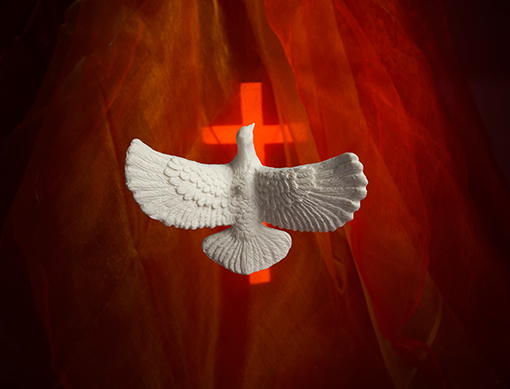 That phrase was used by St. Pope John Paul II to describe the People of God, filled with joy and faith because of Christ’s Resurrection.
That phrase was used by St. Pope John Paul II to describe the People of God, filled with joy and faith because of Christ’s Resurrection.
If we follow what happens to the Apostles and the Church after the Resurrection, we could also exclaim, “We are a Pentecost People!” That means we are a people powered by the Holy Spirit.
In a Pentecost Sunday homily, Pope Francis reminded the faithful that on Pentecost, the Holy Spirit transformed “timid disciples from fearful men, ‘huddled behind closed doors,’ to bold men who ‘bear witness to [Jesus]’.”
He was describing what happened following Jesus’ Resurrection, when the Apostles were often behind locked doors, afraid of the Jewish authorities. It was here that Jesus appeared to them for the first time.
During the next forty days, though Jesus continued to appear to them, some of the Apostles went back to their old lives as fisherman. On one occasion, Jesus appeared and told them not to leave Jerusalem but to wait for “the promise of the Father,” which Jesus had spoken about.
I often wondered if he got wind of some of them planning to leave town!
It was after the Apostles witnessed Jesus’ Ascension that things began to change. They gathered together in the Upper Room, with Mary and some other women, to pray. They probably remembered Jesus’ promise that the Holy Spirit would come after Jesus went back to his Father.
It was then that the Holy Spirit arrived in wind and tongues of flame, transforming the ordinary disciples of Christ into bold, courageous proclaimers of the Gospel. On that day, Peter, once a fisherman with no higher education, the Apostle who, motivated by fear, denied he even knew Jesus after Jesus was arrested, rose to his feet and preached with the power of the Holy Spirit and 3,000 people were baptized. The Church was born.
While many lessons on Pentecost focus on the images of wind and flames and the color red, all of which are meaningful, I believe that the story of Pentecost can encourage today’s youth to have faith in the transforming power of the Holy Spirit.
In another Pentecost Sunday homily Pope Francis stresses that the Holy Spirit “sets our lives in order. He teaches us to accept one another, to forgive one another and to forgive ourselves; he teaches us to be reconciled with the past. And to set out anew.”
Teaching Pentecost in the classroom:
Your RCL Benziger grade-level texts will have excellent, valuable lessons on Pentecost. For middle school students and older, consider adding a conversation on transformation to the lesson. Be sure to include the story of Peter’s transformation.
• Can people change what’s in their hearts and minds? How does that happen? Has that ever happened to you or someone you know? How do you think the Holy Spirit, the third person in the Holy Trinity, can help you accept one another, forgive one another, forgive yourself, reconcile with past hurts and mistakes, and start out fresh?
• Add this brief prayer from Pope Francis as you begin each day: ‘Come, Holy Spirit, come into my heart, come into my day.’
For Teachers: Wisdom from two saints. In his own message for Pentecost Sunday 2001, St. Pope John Paul II shared the words of St. John XXIII about the power of the Holy Spirit. – "The light of the Holy Spirit breaks forth from the first words of the Book of the Acts of the Apostles.... The intense movement of the divine Spirit precedes and accompanies the evangelizers and breaks into the souls of those who listen, while extending the confines of the Catholic Church to the ends of the earth, allowing her to traverse all the centuries of history" (Discorsi Messaggi Colloqui del S. Padre Giovanni XXIII, II, p. 398).
 About the Author
About the AuthorMary Clifford Morrell, mother of six and grandmother to ten, is a Catholic journalist, editor, and author who has served the Dioceses of Metuchen and Trenton, New Jersey; Burlington, Vermont, and RENEW International in the areas of religious education and communication.
Pagination
Latest
Categories
Archives
- February 2015 (2)
- March 2015 (2)
- April 2015 (5)
- May 2015 (3)
- June 2015 (6)
- July 2015 (3)
- August 2015 (5)
- September 2015 (5)
- October 2015 (4)
- November 2015 (2)
- December 2015 (1)
- February 2016 (2)
- March 2016 (1)
- April 2016 (2)
- May 2016 (2)
- July 2016 (2)
- August 2016 (2)
- September 2016 (1)
- October 2016 (5)
- November 2016 (1)
- December 2016 (3)
- January 2017 (2)
- February 2017 (3)
- March 2017 (2)
- April 2017 (1)
- June 2017 (2)
- July 2017 (2)
- August 2017 (1)
- April 2018 (1)
- October 2018 (2)
- December 2018 (2)
- February 2019 (3)
- March 2019 (2)
- April 2019 (2)
- May 2019 (3)
- June 2019 (1)
- July 2019 (16)
- August 2019 (8)
- March 2020 (4)
- April 2020 (6)
- May 2020 (8)
- June 2020 (7)
- July 2020 (5)
- August 2020 (7)
- September 2020 (4)
- October 2020 (5)
- November 2020 (9)
- December 2020 (11)
- January 2021 (10)
- February 2021 (8)
- March 2021 (5)
- April 2021 (4)
- May 2021 (4)
- June 2021 (5)
- July 2021 (2)
- August 2021 (3)
- September 2021 (4)
- October 2021 (4)
- November 2021 (2)
- December 2021 (5)
- January 2022 (4)
- February 2022 (4)
- March 2022 (9)
- April 2022 (7)
- May 2022 (9)
- June 2022 (12)
- July 2022 (7)
- August 2022 (10)
- September 2022 (9)
- October 2022 (11)
- November 2022 (8)
- December 2022 (7)
- January 2023 (2)
- February 2023 (10)
- March 2023 (9)
- April 2023 (10)
- May 2023 (8)
- June 2023 (4)
- July 2023 (3)
- August 2023 (2)

